12 Amazing Aloe Varieties Chosen For Your Home By Elizabeth Waddington

SUCCULENTS > ALOE > VARIETIES

Elizabeth is a Permaculture Garden Designer, Sustainability Consultant and Professional Writer, working as an advocate for positive change. She graduated from the University of St. Andrews with an MA in English and Philosophy and obtained a Diploma in Applied Permaculture Design from the Permaculture Association.
Reviewed By DAN ORI

Dan has over 27 years’ under his belt caring for plants and gardens. Working as a Horticultural Instructor and Consultant, he draws on a diverse range of experience that includes working as a Head Gardener, Tree Surgeon, Garden Centre Trouble Shooter, and writer of academic papers. Dan has a Level 3 Diploma in Horticulture and is currently a candidate for the RHS’s most prestigious award – The Master of Horticulture.
IN THIS GUIDE
ALOE GUIDES
Overwintering
Propagation
Varieties
Watering
Aloes are popular sculptural succulent houseplants that are easy to grow in containers and are prized for the appearance of their spiral rosettes of succulent leaves.
Aloes are typically grown as houseplants in the UK, but hardiness varies and some can be placed outside in a suitable spot – at least during the warmer part of the year.
They are easy to grow in containers using a cactus compost or another good quality peat-free mix – with sharp sand or grit added to improve the drainage.
You cannot go too far wrong when growing any Aloe if you provide it with free-draining, frost-free conditions and ensure that the surroundings are not too humid.
The best-known is perhaps Aloe vera, which is grown not only for its visual appeal but also for its various uses in natural produce, but there are plenty of others to consider.
Here are some interesting and highly regarded Aloe varieties to grow.
1) A. arborescens ‘Variegata’

- COMMON NAME(S): variegated candelabra aloe
- HARDINESS RATING: H1C
- FOLIAGE: yellow and green
- FLOWERS: red
This perennial forms rosettes of succulent, toothed, sword-like leaves that are mid-green, and striped with a pale yellow.
Occasionally, this plant also produces red, tubular flowers held erect in terminal racemes.
2) A. bakeri

- COMMON NAME(S): baker aloe
- HARDINESS RATING: H1B
- FOLIAGE: white and green
- FLOWERS: orange and red
Also known as ‘Baker Aloe’, this perennial succulent grows to around 20cm tall, forming mats of dark green rosettes made up of narrow leaves which are speckled with white.
The plant also sometimes boasts reddish-orange racemes of flowers.
3) A. brevifolia
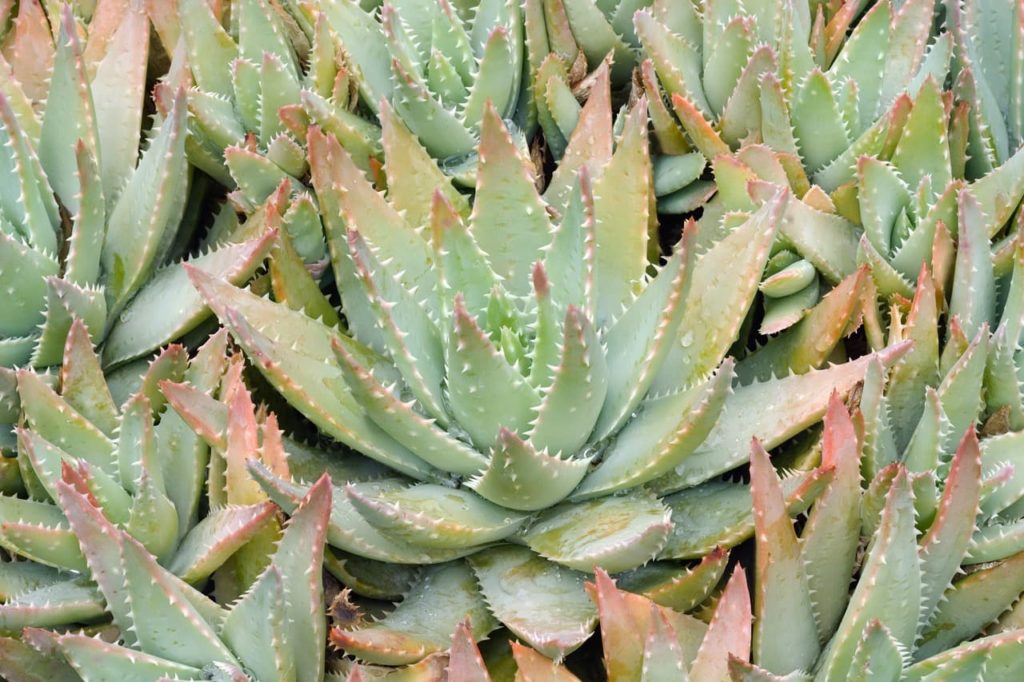
- COMMON NAME(S): short-leaved aloe
- HARDINESS RATING: H2
- FOLIAGE: green, silver and grey
- FLOWERS: red
Short-leaved aloe is the common name for this variety – it is a mat-forming perennial succulent.
It forms rosettes of spreading, toothed, triangular leaves and its 4cm flowers are red and are also carried in racemes above these rosettes of leaves.
4) A. descoingsii
- COMMON NAME(S): descoings aloe
- HARDINESS RATING: H1B
- FOLIAGE: white and green
- FLOWERS: orange
Descoings aloe is a mini variety that forms low clumps of just 6cm.
It has greyish-green succulent leaves with toothed margins and white speckles.
When placed on a sunny windowsill, it can produce a flower stalk in spring and summer and bear urn-shaped flowers of a dark orange hue.
5) A. haworthioides
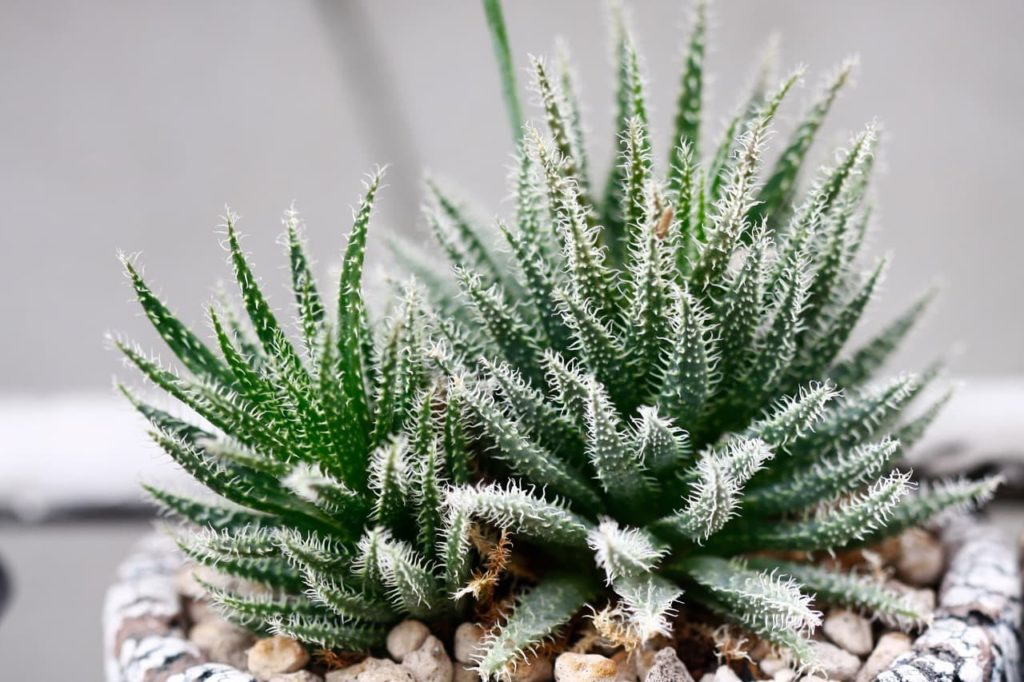
- COMMON NAME(S): haworthia-leaved aloe
- HARDINESS RATING: H1C
- FOLIAGE: green
- FLOWERS: orange
Haworthia-leaved aloe is small but fast-growing.
It reaches around 10cm in height with its rosettes of succulent leaves, which are dark green, lanceolate and covered with soft, white, hair-like spines.
In addition to this, its flowering stems, with their tubular orange flowers in late summer, can reach around 30cm tall.
6) A. ‘Lizard Lips’
- COMMON NAME(S): aloe ‘lizard lips’
- HARDINESS RATING: H1B
- FOLIAGE: green, cream and white
- FLOWERS: orange
Growing to around 15cm tall and 20cm in diameter, this aloe forms rosettes of tapered leaves in green, with interesting patterns in lighter green and creamy white edges with little white teeth.
Tall spikes form in the summer, bearing tubular orange flowers.
7) A. polyphylla

- COMMON NAME(S): many-leaved aloe
- HARDINESS RATING: H3
- FOLIAGE: green
Known as the many-leaved aloe, this option is prized for its spiral form.
The fleshy leaves form a pronounced spiral pattern.
They have white or pale green spines along the edges and single brown spines at their upper tips.
The flowers which appear on a branching spike in spring are typically red with greenish-yellow tips but can vary in hue.
8) A. rauhii ‘Snowflake’
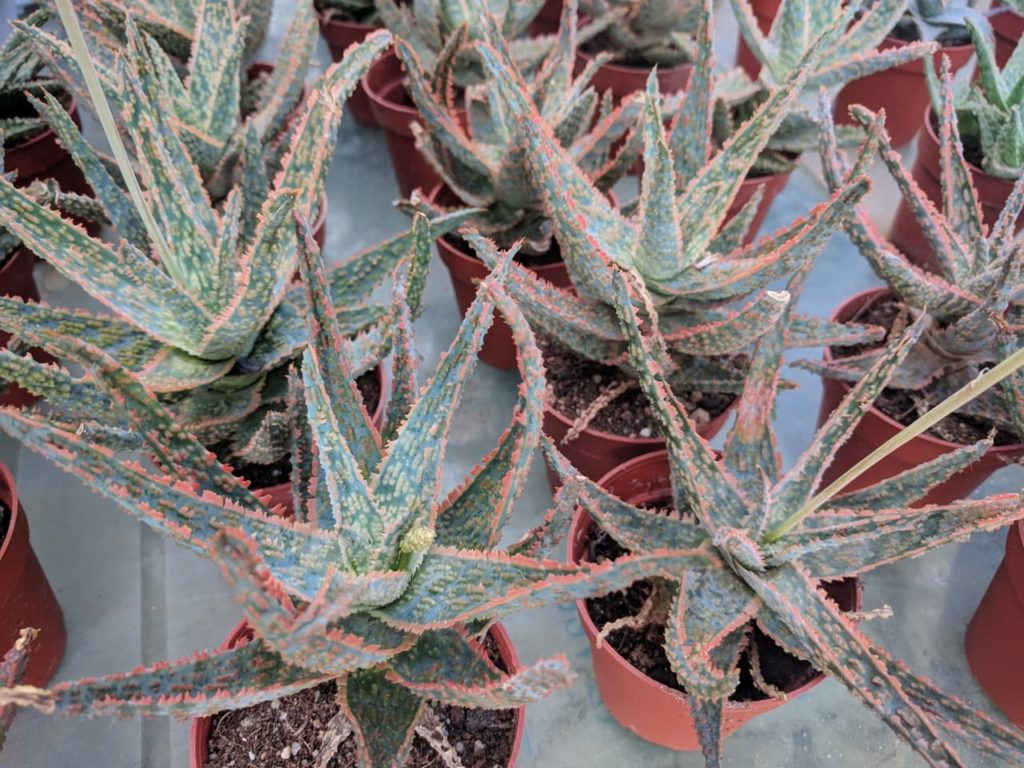
- COMMON NAME(S): snowflake
- HARDINESS RATING: H1B
- FOLIAGE: green and brown
- FLOWERS: pink and red
This rather rare succulent is stemless and evergreen.
It forms rosettes of lanceolate leaves with a grey-green hue that have lighter green patterns upon them and little white teeth along their sides.
The leaves are sometimes flushed brown when exposed to strong direct sun.
The flowers, borne in summer on 30cm high stalks, are of a pinkish-red colour.
9) A. somaliensis
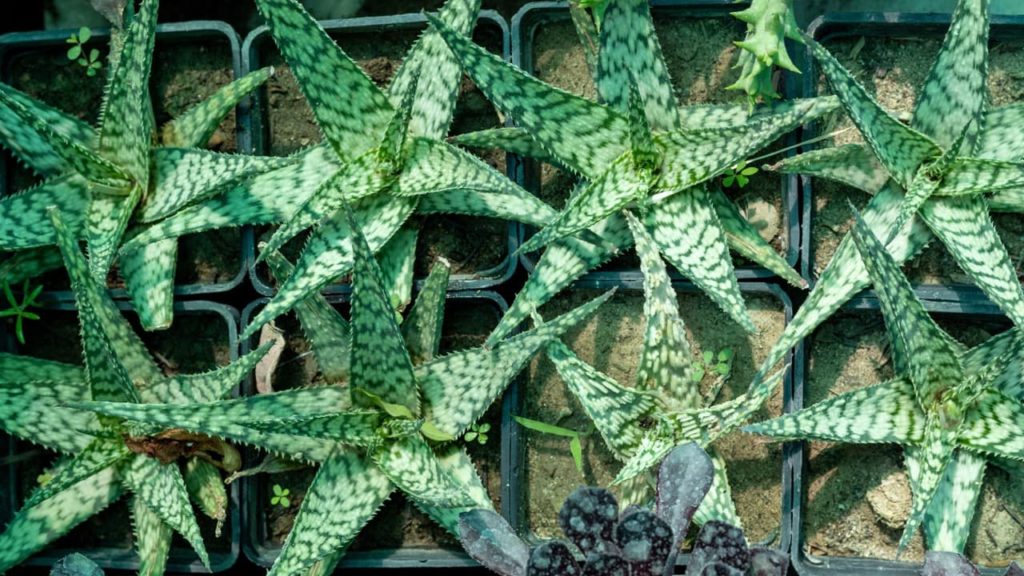
- COMMON NAME(S): Somalian aloe
- HARDINESS RATING: H1B
- FOLIAGE: green and white (variegated)
- FLOWERS: pink and red
Somalian Aloe has attractive variegated leaves like the above, which are green with lighter green patterning and light green to white teeth along the edges of each one.
In the late summer, this aloe sends up spikes that can be 60-80cm in height, bearing tubular flowers in pale pink to red hues.
10) A. striatula
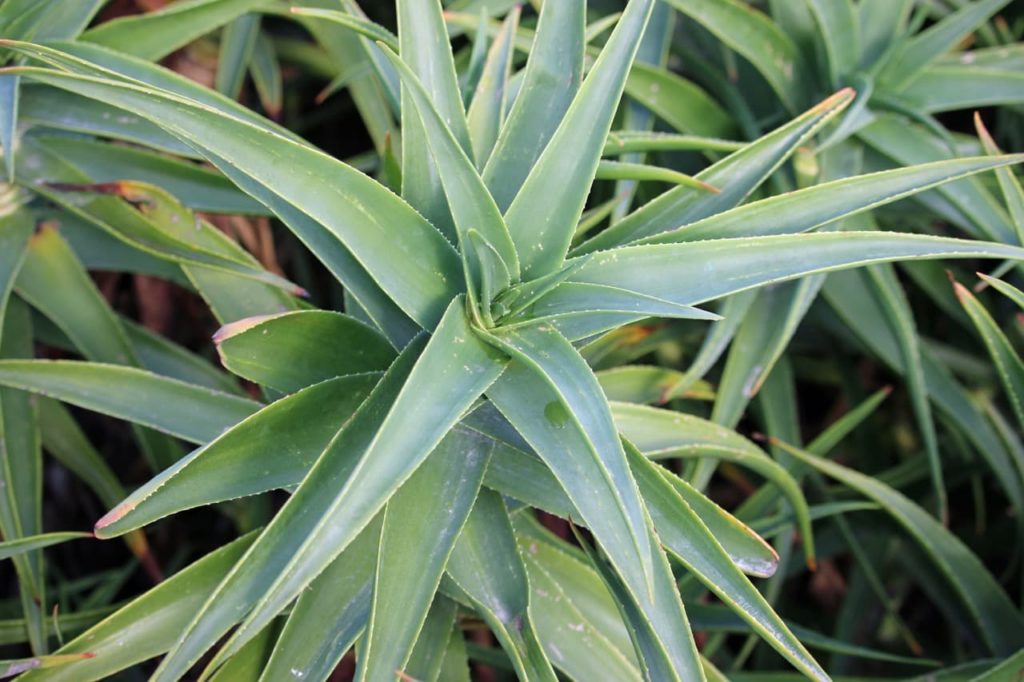
- COMMON NAME(S): striped-stemmed aloe
- HARDINESS RATING: H3
- FOLIAGE: green
- FLOWERS: yellow
Known as stripe-stemmed aloe, this evergreen succulent has scrambling, bushy stems that, as the name suggests, are striped with light and dark green.
The leaf sheaths are also striped in the same way.
Dramatic racemes of vivid yellow flowers with orange stems protruding from them form on spikes around 40cm tall in the summer months.
11) A. variegata
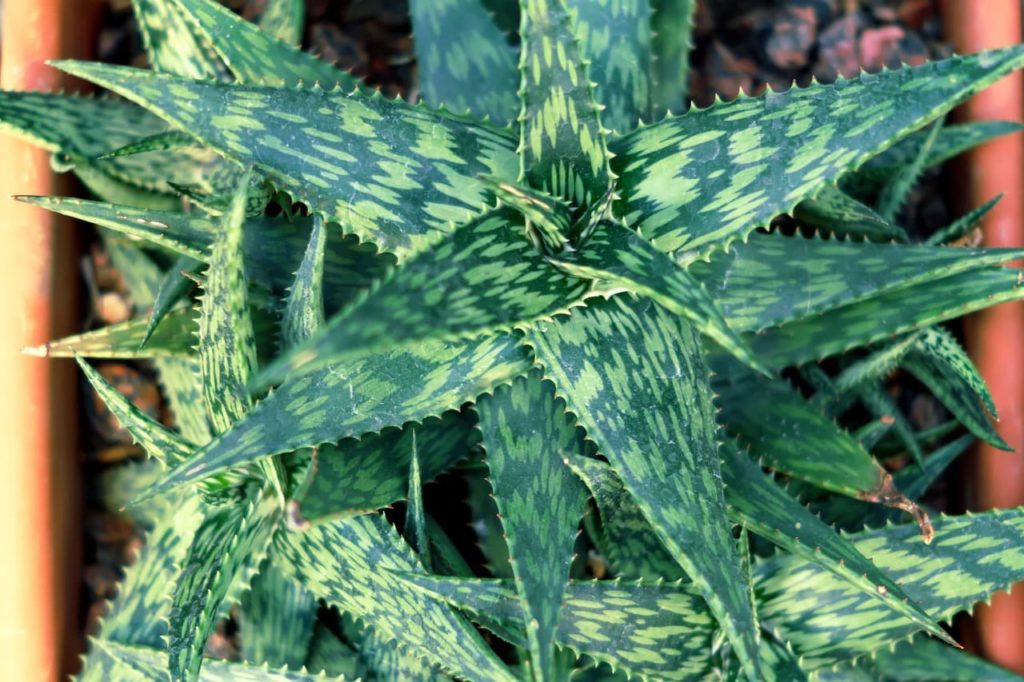
- COMMON NAME(S): partridge-breasted aloe
- HARDINESS RATING: H1C
- FOLIAGE: green and white (variegated)
- FLOWERS: red and orange
Also known as partridge-breasted aloe, Aloe variegata is a familiar houseplant to some.
It grows around 20cm tall, forming rosettes of its stiff, fleshy, dark-green leaves that are banded distinctively with broadly horizontal white stripes.
Racemes of flowers form in the summer, which are salmon-red in colour.
“This is my favourite Aloe as it’s robust and revives well from over and under-watering, as well as possessing an attractive variegation that looks painted on by a fine brush,” explains Master Horticulturist Dan Ori.
12) A. vera
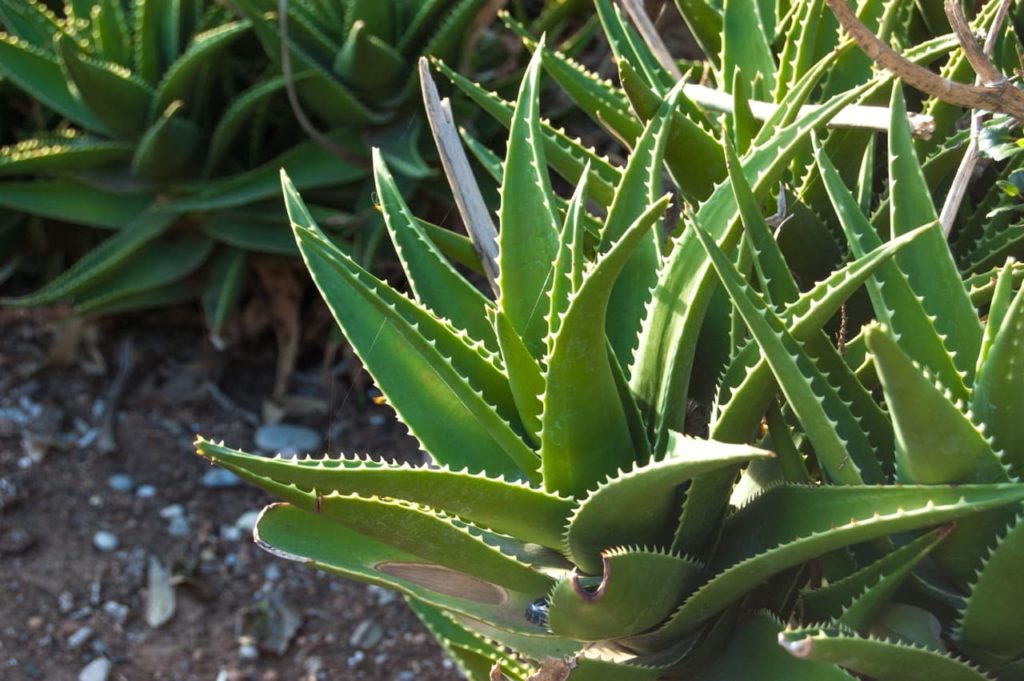
- COMMON NAME(S): Barbados aloe
- HARDINESS RATING: H1C
- FOLIAGE: green
- FLOWERS: green and yellow
Last but certainly not least, the most common Aloe of all is Aloe vera, also known to some as Barbados Aloe.
It can grow up to around 60cm tall, forming rosettes of fleshy, lance-shaped leaves with spiny edges.
The flowers when these form are greenish-yellow and are around 3cm in length.
These are held above the leaf rosettes in racemes that can reach around 90cm in height.
There are plenty of other Aloes and related succulents to grow, but in the list above, you should find some ideas with which you can expand your houseplant collection.
